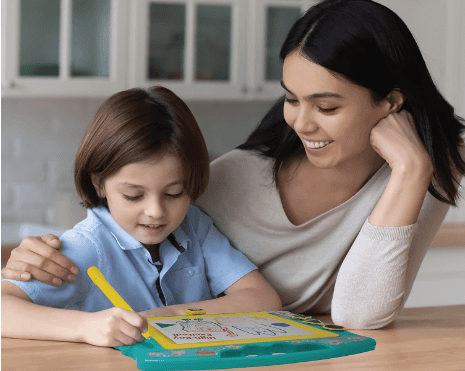East-to-Follow Tips to Help A Child with Handwriting & Pencil Grip

|
Getting your Trinity Audio player ready...
|
Why Does Pencil Grip Matter?
When learning to write, some children have difficulty developing an effective pencil grip. Holding a pencil with the right grip and appropriate amount of strength can make a big difference in a child’s handwriting.
What Can Parents and Teachers Do?
Parents and teachers can use strategies to help children improve the strength in their hands, how they hold their pencil, and the overall appearance of their handwriting.
Learn About the Tripod Grip
A common grip taught to children when developing handwriting skills is the tripod grip. The tripod grip is an effective way to use hand muscles when writing. The child holds the pencil with their thumb and index finger, while the pencil rests on their middle finger. See an example below.

Some children learn the tripod grip naturally, while others need help from parents and teachers. It is recommended to teach the tripod grip when a child learns to write his or her own name, generally around age five.
What You Should Know When Teaching the Tripod Grip?
The child should not be gripping the pencil too tightly. Signs a child is holding a pencil too tightly include:
- Rips in the paper
- Pencil tips frequently breaking
- White knuckles when writing
The child’s fingers should be relaxed so their hand will not tire too quickly. Specifically, observe the index finger knuckle for signs of redness or whiteness which would indicate pressure on the joint. Also, ensure your child is not making a fist.
For children who consistently hold the pencil too tightly, make a fist, or put pressure on the joint of the index finger, you can ask them to hold a small ball of clay or tissue, a small rubber ball, or a penny in their palm when they write. This should help relax the grip. See an example below.

Ensure the grip is close to the tip as in the pictures above. Holding the pencil too far back allows for less writing control.
Related Article: How to Teach Children to Write Letters & Numbers with Correct Form and Positioning
How Should a Child Sit When Learning to Write?
To ensure correct positioning of your child’s body when writing, check that they are sitting with their feet flat on the floor and her bottom in the center of the chair’s seat. See correct body posture for writing in the image below.

Keep in mind that some children have significant difficulty sitting this way for long. While it is best to encourage this posture, do not stop a writing lesson if a child struggles to sit this way. Just do the best you can to encourage them.
The child should use their free hand to hold the paper in place as they write. For children who have trouble holding the paper, you can tape the paper to the table.
Give Choices
Let your child choose and practice the tripod grip with different writing tools such as pens, markers, crayons, pencils, and coloring pencils. Another great tool to practice writing and pencil grip is the stylus for the IPAD.
Occupational therapists who often work with children on handwriting and pencil grip skills have recommended a grip-friendly stylus such as the Universal Capactive Stylus Pen.

Many children who do not like to practice handwriting the traditional way, are eager to practice with writing apps.
Additional Strategies to Improve Handwriting and Pencil Grip
- Try using a rubber band. This is an effective strategy for some children. A rubber band helps keep the pencil in place, while allowing the pencil to slant naturally. Twist the rubber band once around the pencil and then around the child’s wrist as shown below.

- Encourage frequent practice through writing, drawing, or both
- Sessions should be short (5 to 10 minutes for younger children or children who get easily frustrated and 10 to 15 minutes for older children or children who can work for longer periods without frustration)
- Let your child know when they are putting forth good effort or making progress with their skills (e.g., you worked hard on your writing today, you have been practicing hard, you wrote very nicely today).
- Let your child know how they can improve (e.g., try pressing a little lighter, open up your fist, move your fingers closer to the tip, etc.)
- Give students choices within the classroom or for homework as much as possible. Research shows that children are more eager and willing to participate when they have some choice and flexibility within the activity.
- Remember to always stay calm when working with a child or student, even if you think they should be getting something that they are not getting. If you get frustrated with them, they may start to feel anxious, angry, inferior, stupid, etc. which will lead to a less productive learning session.
Are There Specific Tools for Writing and Pencil Grip?
For children who have significant difficulty developing the tripod grip after consistent guidance and practice, try using tools to assist your child with grip development. Two highly-rated tools by parents, educators, and specialists are the The Pencil Grip Writing Claw, shown here:

and the Pencil Grip Original Universal Ergonomic Writing Aid, shown here:

Since not every tool will work for every child, you will find some mixed reviews on these products; however, The Pencil Grip Writing Claw, and the The Pencil Grip Original Universal Ergonomic Writing Aid both have positive ratings overall.
Why Should Some Students Use Broken or Worn Down Crayons or Very Short Pencils?
It is difficult to use a fist grip on a writing utensil that is that short. The hand automatically goes into a pincer type grasp similar to the tripod grip and the quadropod grip shown below.

What is The Quadropod Grip?
The quadropod grip is also an acceptable grip. If a child develops the quadropod grip naturally and is using it effectively, there is no reason to change their grip.
Additionally, if a child has trouble developing the tripod grip after trying different strategies and practicing consistently, you could try teaching them the quadropod grip. All the same strategies listed above should be utilized when teaching the quadropod grip.

What If My Child Needs More Support Thank I Can Provide?
Keep in mind that every child is different. Some respond to several strategies, others respond to a few, while others may not respond to any of these strategies. If your child is significantly struggling with pencil grip or other fine motor skills (e.g., using scissors, buttoning, zipping, using utensils, picking up small objects, etc.) despite consistent practice and guidance, inform your child’s school and/or doctor. They should be able to get a specialist involved such as an occupational therapist to determine what might be interfering with your child’s fine motor progress and what additional strategies might help.
If you are a teacher, inform your student’s parents and the school team if you believe more assistance is needed than what you provide.
References:
Occupational Therapy for Children and Adolescents
Evaluating Effective Pencil Grasps
Video Presentation of Article:
You may also find this video helpful which suggests activities for improving hand-strength. When fine-motor muscles are stronger, pencil grip is easier!
Recommended Tools to Improve Handwriting and Pencil Grip
Recommended Hand-Strengthening Tools for Kids:
Education and Behavior – A free online library of research-based strategies for children! Keeping parents, caregivers, educators, counselors, and therapists on the same page.
Please share this resource!






